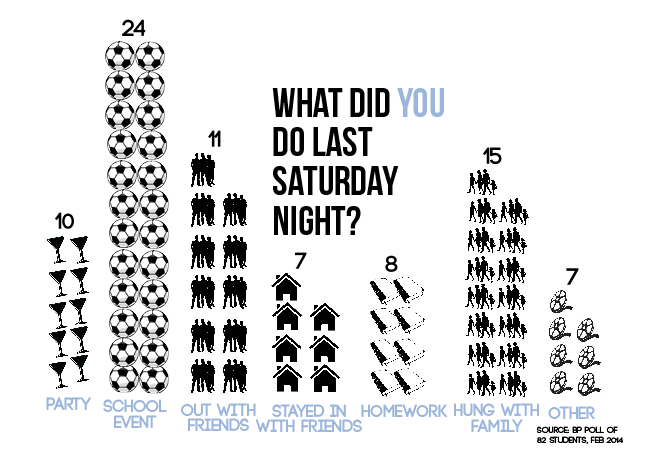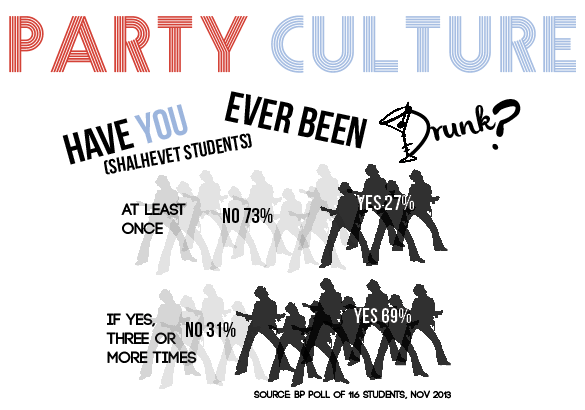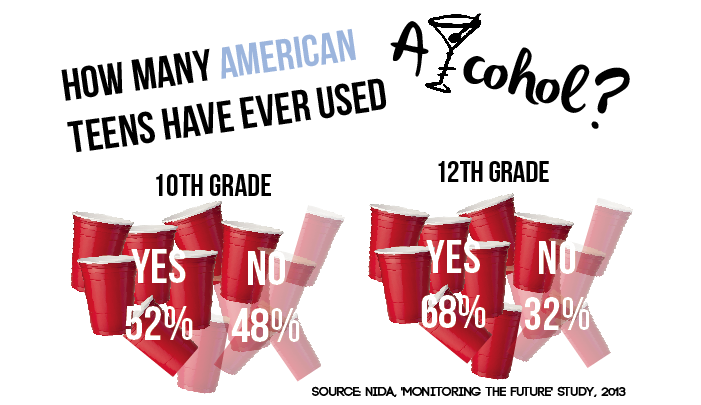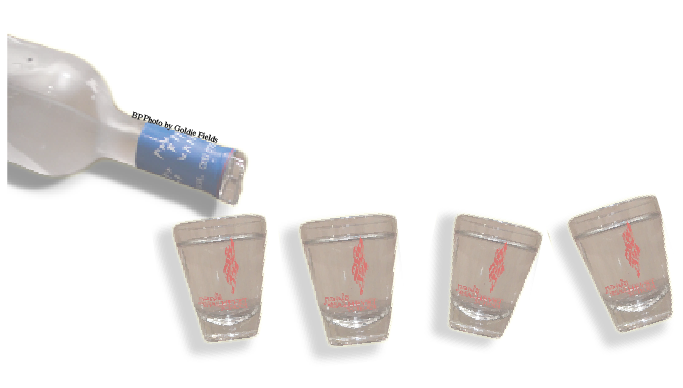Party Culture
About a quarter of Shalhevet students have been drunk, way below national averages. Homework and school events compete for their attention, but those who party give the usual reasons.
March 12, 2014
A full bottle of vodka lay nestled in a bush, out of anyone’s line of vision in the unlikely case a parent would come home. A few sophomores lounged on a couch, speaking incoherently as one of their friends hunched over, about to vomit. He barely made it outside before letting it all out, drunkenly apologizing for the mess.
This may not happen every week, or to most Shalhevet students, but back in October this scene was a reality when a sophomore invited a few friends over to his house.
“I had some camp and school friends over and their friends dropped by with alcohol and left it there at my house,” said Jonathan* the boy who hosted.
“Then we decided that it might be fun to take a shot or two. A couple people got drunk and some other people got more than drunk. A lot of people started hooking up and and others were just hanging out.”
One kid started vomiting, so Jonathan said he had to sober up in order to clean up the mess and help those who were sick.
“Other people just kind of hung out and talked,” he said. “It wasn’t like a crazy party, just a kickback.”
The incident was probably a Saturday night anomaly – at least for a large majority of Shalhevet students. An anonymous poll of 116 students, conducted by The Boiling Point during Advisory last November, indicated that 73 percent had never been drunk.
Another 27 percent of students had been drunk at least once, most of them three or more times.
The Boiling Point’s poll was worded differently than national surveys, because nearly every Shalhevet student has “drunk alcohol” on Shabbat or other holidays, and the student body is too small to have gathered meaningful numbers from just one grade.
But depending on how respondents define the word “use,” Shalhevet’s numbers may be nearly opposite the national average. The National Institute on Drug Abuse, or NIDA, has been studying teen drinking habits since 1975. Its 2013 study reported that 52 percent of 10th graders and 68 percent of 12th graders had “used” alcohol.
Many studies ask about teen behavior in the preceeding 30 days. When the Centers for Disease Control (CDC) administered a poll in 2011, 39 percent of teenagers had imbibed some amount of alcohol in the previous month.
And another study, the National Survey on Drug Use and Health (NSDUH) sponsored by the U.S. Department of Health and Human Services, found that in 2010, 25 percent of 16- and 17-year-olds had used alcohol within the past month. Of these, 62 percent had been “binge drinking,” meaning five or more drinks at a time (four for girls). Rates for 14- and 15-year-olds were about half that.
The comparison is far from exact. But the numbers suggest that Shalhevet students have been drunk slightly more times over the course of their entire lives as teens nationally have been just within the past 30 days.
Drinking and partying are definitely not the only thing Shalhevet students do on Saturday nights—the poll also showed that 75 percent of students had stayed home on at least one Saturday night last semester to do homework—and 56 percent stayed home three or more times.
Still, even as a minority activity, drinking exists in Shalhevet’s party culture, and is somewhat more prevalent the older students get. The percentage of Shalhevet students who have been drunk was significantly higher for upperclassmen than for underclassmen—37 percent and 19 percent, respectively. The proportion of students who have been drunk three or more times was also higher for upperclassmen than for underclassmen, with upperclassman at 25 percent and underclassmen at 12 percent.
Interviews with students suggested that Shalhevet’s party culture is fairly low pressure—it’s there if you want it, but it’s not a crucial component of a student’s social life. Many also said that partying and drinking is not as prevalent among Shalhevet kids as with students at other schools in the area.
Senior Kaili Finn was not surprised at the fact that Shalhevet’s numbers are lower than teenage drinking rates across the country, and that she thought the relatively low rates are partly because of the students’ relationships with teachers.
“Shalhevet kids party but it’s not nearly as much as other schools in the area, let alone the country,” Kaili said. “It’s not built into the culture of the school.”
“I think it’s because we have such good relationships with the teachers. I’m not saying we’re better kids, but in a way we’re more responsible. You think about what your teachers would think if they knew what you did. I care what they think about what I do, because I look up to them.”
For Kaili, a typical Saturday night would entail going to a party or a kickback (a smaller gathering at a friends’ house). She added that most Saturday night parties aren’t hosted by Shalhevet kids but by kids from other schools in the area, and alcohol is almost always present.
“If there were Shalhevet parties I would go, but there aren’t really,” Kaili said. “If it is a Shalhevet event, it’s more like a couple people hanging out, it’s not like a crazy party.”
Though Kaili is often around environments with alcohol, she added that she tries to think responsibly and make careful choices.
“When I go to parties I think of the consequences of things before I do them. Like I’ll go to parties but I don’t go crazy like other kids do. Some kids at other schools don’t care about drinking and driving, crazy things like that.”
 Junior Jillian Einalhori also mentioned that Shalhevet’s party scene is tamer than that of other schools, and that her Saturday night decisions are influenced by the open environment at school and the faith teachers have in the students.
Junior Jillian Einalhori also mentioned that Shalhevet’s party scene is tamer than that of other schools, and that her Saturday night decisions are influenced by the open environment at school and the faith teachers have in the students.
“Generally, Shalhevet’s students aren’t as crazy as the other schools’,” Jillian said, naming other Jewish or nearby public high schools, “because I think that we do have relationships with teachers in a way that they’re concerned about what we do. They are like parents to us in a way that they’ve instilled good values in us of how to act and be responsible. The faculty really has faith that we’ll make the right decisions.”
“If I’m doing something I know I shouldn’t be doing, it’s probably because my teachers talked to me about it. It’ll always be in the back of mind even if I don’t want to listen to myself. Like there’s always a teacher I’ve talked to about making these decisions, so I’ll hold back.”
When they do drink, alcohol is not hard to find. There are several different ways students can obtain alcohol—either from a friend, stolen from their parents, or by using a fake ID.
According to the 2010 NSDUH study, 81 percent of underage drinkers paid for alcohol the last time they drank—eight percent of whom paid for it themselves, presumably with a fake ID, and 22 percent who gave money to someone else to buy it. Those who did not pay for the alcohol themselves received it from either an unrelated person over 21 or an adult family member.
“Sometimes we take it from our own houses, from our parents alcohol stash, or we get somebody to buy it for us,” Jonathan said. “Namely someone with a fake ID. You text them and invite them to a party or kickback and ask them to bring alcohol and say that you’ll pay.”
Junior Ellie* said that when she and her friends drink, “we’ll go to someone’s house, drink there, then go to a party afterwards.”
As for why students drink on the weekends, Ellie said that it’s a way to let loose and temporarily disregard the high standards people hold them to at school.
“I think it’s just that people think they’re so uptight and when they drink they can do whatever they want at a party and blame it on being drunk,” Ellie said. “It’s also a stress reliever. People all have so much pressure to do well and be one way, and when they’re at a party and going out, they can take that all away.”
“Kids act like people don’t know what they do out of school, then they go out on the weekends and they’ll party, they’ll drink, and act more irresponsibly than they say they act in school,” she added.
“It feels so badass and it’s fun,” said Alyson*, a sophomore who drinks with friends about once a month. “It feels good. And if you’re normally shy and you’re going out to a party it makes you less self-conscious. So for me, if I’m meeting someone new and I’m drunk, I don’t have to care as much.”
Alyson, who goes to friends’ houses to drink, also said that drinking is a way to rebel without getting caught.
“You know you’re not supposed to do it, so it’s a small way to just do something that you’re not supposed to without getting in a lot of trouble, or without your parents knowing,” she said. “I know it would piss my parents off, so it’s fun to do it if they don’t know.”
As the Boiling Point poll indicated, a significant majority of underclassmen have not been drunk. So what do they do on a Saturdaynight?
Freshman Kat*, who has never been to a high school party with alcohol before, thinks that her grade doesn’t party because they’re not at that stage of their life just yet.
“Ninth graders don’t ‘party,’” she said. “We have kickbacks. We sit around and talk. We just hang out. I think that’s going to change as we get older though.”
Kat’s friend Aliza*, also a freshman, went to her first high school party last semester.
“I went with another freshman girl because she wanted to see someone and wanted me to come with her, so we went to a 10th and 11th grade party,” Aliza said. “That was the first time I had been to something like that and I was uncomfortable. There was alcohol and stuff. There were only three girls from my grade there.”
Older students may be more likely to drink, but they may also be more able to resist peer pressure. Senior Yosef Nemanpour says that he feels no pressure to go out and party on the weekends, though he feels like a fair number of students do.
“For me, if I do have plans, they’re kosher — if the word ‘party’ is associated with it I generally won’t go,” Yosef said. “But I feel like I’m an outlier here. I feel like the average Shalhevet students do go to parties.
“I believe that it’s present, you go through the halls and there are conversations once in a while about ‘are you going to this party’ so I’m sure it’s there, I just don’t experience it. I have no urge. No pressure. It’s not me, so I’m not going to put myself in the position if it’s not me.”
Head of School Rabbi Ari Segal was not surprised at how Shalhevet’s drinking rates compared to the national averages, but he would still like to see them lowered.
“I’m happy to hear that our numbers are lower, and I think it does speak to the culture we have at the school and it speaks to the fact were helping kids make smart decisions,” Rabbi Segal said. “We’re teaching them to be thoughtful, critical thinkers and discerning consumers.”
“We’re higher than maybe we should be, but at the end of the day there are always going to be kids who do this,” he said. “It’s just about teaching them to make better decisions the next time.”
Rabbi Segal added that he thinks learning Torah and living in a Jewish environment probably influences the decisions teenagers make.
“The Torah discussions force you to think about issues from lots of perspectives –Torah discussions force you to be less egocentric,” he said. “You recognize that you’re not the center of the world, God is.”
“When you think of a true Torah life, the whole sense of religion helping you realize that we are living in a theocentric world—that helps you to formulate healthier choices,” he added. “You might make a mistake, but maybe you’re less likely to make multiple ones.”
Jonathan doesn’t think that students are thinking about Torah when making these decisions, and he doesn’t think he or other teens will stop partying if they learn Torah often.
“I don’t think that teens make the correlation between Torah and these decisions with drinking as having a direct effect on the other,” he said. “They’re not going to be making these decisions with Torah in mind, especially in the moment, and even after the fact.”
As Rabbi Segal indicated, the school takes an educational, rather than punitive, approach to teenage drinking. Principal Reb Noam Weissman said that instead of reprimanding students for dangerous behavior on the weekend, he will speak to them about it and inform them of potential dangers and consequences.
“When our students do mess up, our approach is to edcuate them, not to tell them they have detention or are suspended,” Reb Noam told the Boiling Point. “Our initial reaction is something reparative and educational, so they feel comfortable talking to us about it, which in turn makes us more aware of what our students do.”
“It’s not like I have a mole who calls me,” Reb Noam said. “It’s not such a formal thing, I’m just not so removed. I know what high schoolers are doing.”
The week after Jonathan’s get-together, Reb Noam and Rabbi Segal called him into their office to discuss what had happened. Jonathan said that while it was not a punitive conversation, he felt like he was in trouble. He also said that talking to the administration about drinking put an uncomfortable strain on their relationship.
“It felt like it was a little bit of an invasion of privacy because it was outside of school, and then I was put in an uncomfortable position when I was in school,” Jonathan said. “I also feel like our relationship was changed after that, because I’ll always feel that they think less of me.
“It made me feel like I had made a stupid decision, and that in the future I wouldn’t want to have anything like that at my house,” he added. “It’s not necessarily going to stop me [from drinking] though, because I know that they’re looking out for me, but I’m going to make my own decisions.”
Currently, the school has no consistent alcohol and drug education program. In the past, they’ve brought in occasional speakers and conducted seminars on the facts and potential dangers of drugs, alcohol, and drunk driving.
Last year, Dr. Itai Danovitch, the Chair for the Department of Psychiatry and the Director of Addiction Psychiatry at Cedars Sinai, came to speak to students about addiction to drugs and their effect on the body. An organization called Impact Teen Drivers brought Martha Tessmer, whose son was killed in a drunk driving accident, to speak to students about the dangers of drunk driving and the impact her son’s death had on her life.
School Guidance Counselor Rachel Hecht said there are plans to institute a more formal program. In the coming months, she said, an organization called Angels at Risk, which promotes parent-teen communication about alcohol and drugs, will address students and parents separately.
Ms. Hecht said that in order to eradicate peer pressure and teenage drinking in a community, students need to “establish non-use as the norm.”
“The most effective advice that I have for students is for them to base their norms on their own comfort levels and not on those around them,” Ms. Hecht said.
“These adolescent years are a time marked by the need to fit in and be socially accepted by peers, but because the brain isn’t fully developed, healthy decision-making is overlooked and a sense of invincibility takes over. The need to be perceived as cool is often valued more than the need to be safe.”
For those who do feel comfortable drinking, Ms. Hecht advises students to have a plan before going out—to have a driver who will take them home and a person they can call, no questions asked, if they feel unsafe or uncomfortable at any point during the night.
She wants them to fully understand the implications of the decisions they make.
“They need to take on the responsibilities that come with [drinking] and understand their safety comes into play,” Ms. Hecht said. “They need to understand what’s going into their bodies and their reasons for using. Everything needs to be done with as much forethought as possible, in the safest way possible.”
That means having open communication between the students, school and parents, she said. But it also turns out that adults are not that certain what to say.
“It’s about the conversation, education and providing information,” said Ms. Hecht. “[But] it’s a very fine mix and it’s complicated in terms of how to provide information for students to be safe without condoning use.”
In the past, formal drug and alcohol abuse programs have been found, ironically, to increase usage. In 1992, an Indiana University study showed that students with exposure to the nationwide Drug Abuse Resistance Education (DARE) curriculum had higher rates of hallucinogenic drug use.
DARE, which aims for complete avoidance of drug use and gang violence, has generally responded to such studies dismissively, but has also reformed its program. Two other studies have demonstrated the effectiveness of the revised program in reducing drug use among students.
“We’re aware of things that take place and hope that students choose to abstain, but if they’re going engage then we want them to be safe and I want them to be armed with information,” said Ms. Hecht.
Even without a formal alcohol education, some students are still managing to make the kind of thoughtful decisions the administration and teachers are advocating.
“[Not drinking] is definitely a decision that I’ve made from what I’ve seen,” said senior Jennie Drazin. “Being around people who are drunk isn’t always fun and it makes me feel worried for them. It scares me that they don’t know what they’re thinking or doing and that they won’t remember what happened.”
“I don’t want to be that person — I want to always be in control of myself,” said Jennie, adding, “If you’re going to drink, be responsible, don’t be stupid. There’s so much room for stupid mistakes.”
For Jonathan though, being responsible doesn’t mean not drinking. It just means not hosting — suggesting that Shalhevet’s party culture isn’t going to change overnight.
“I haven’t hosted another party like that at my house because I don’t think it would turn out well,” said Jonathan. “But I have been to several similar parties.”
He said he’d been to a party quite similar to the one he held in October, this time at the home of a non-Shalhevet student, just this week.
“I like going but not having to be the one that gets in trouble for it.” he said.
BP Graphics by Margo Feuer



